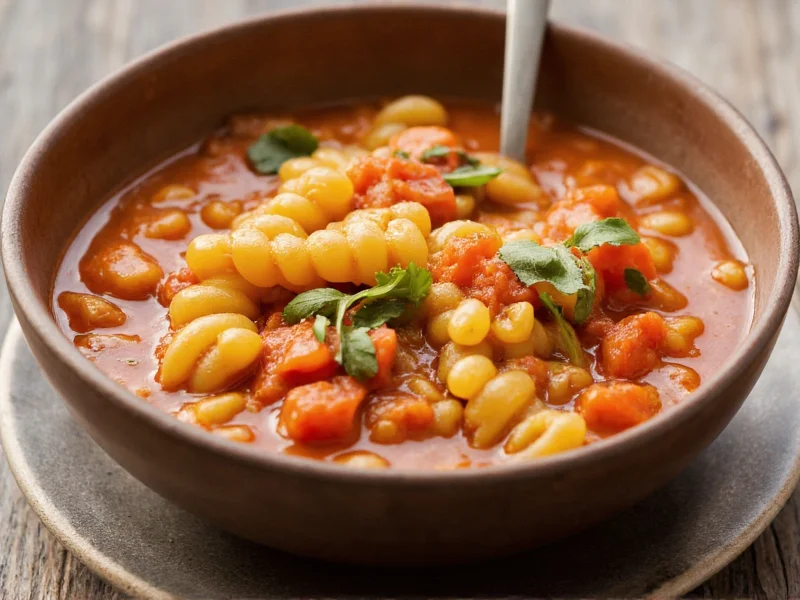Minestrone soup with ditalini pasta represents one of Italy's most beloved comfort foods, transforming humble ingredients into a nutritionally complete meal. Unlike larger pasta shapes that can dominate the dish, ditalini's small size (meaning "little thimbles" in Italian) integrates seamlessly with the vegetables while maintaining its structure during cooking—a critical factor that separates authentic minestrone from inferior versions.
Why Ditalini Makes the Perfect Minestrone Pasta
Ditalini pasta's unique shape and size offer distinct advantages in minestrone preparation. These short, tube-shaped noodles measure approximately 1/8 inch in length, making them ideal for soup applications where larger pasta varieties like penne or rigatoni would overwhelm the delicate vegetable balance. When cooking authentic minestrone soup with ditalini, the pasta absorbs flavors while retaining a pleasant al dente texture through multiple reheating cycles—a crucial characteristic since traditional minestrone improves overnight as flavors meld.
Unlike elbow macaroni or orzo that can become gummy, ditalini maintains structural integrity due to its thick walls and compact shape. This makes it particularly suitable for meal prep scenarios where you need minestrone soup storage and reheating tips to preserve texture. For best results, add ditalini during the final 8-10 minutes of cooking to prevent over-softening.
Traditional Minestrone Ingredients Breakdown
Authentic minestrone soup with ditalini follows seasonal availability while maintaining core components. The holy trinity of Italian cooking—carrots, celery, and onion—forms the flavor base, sautéed in olive oil until fragrant. Traditional recipes incorporate:
| Ingredient Category | Essential Components | Seasonal Variations |
|---|---|---|
| Vegetables | Carrots, celery, onion, garlic | Spring: asparagus, peas; Summer: zucchini, green beans; Fall: pumpkin, cabbage; Winter: kale, potatoes |
| Beans | Cannellini beans (most traditional) | Borlotti, kidney beans, or chickpeas as alternatives |
| Liquids | Tomato passata, vegetable broth | Fresh tomatoes in season, wine for deglazing |
| Finishes | Parmesan rind, fresh basil, olive oil | Pecorino, parsley, lemon zest |
For the most flavorful minestrone soup with cannellini beans recipe, include a Parmesan rind during simmering—it adds umami depth without saltiness. The beans should be added canned (drained and rinsed) or pre-soaked and cooked separately to maintain texture. Never skip the final drizzle of quality extra-virgin olive oil before serving, which elevates the entire dish.
Step-by-Step Preparation Guide
Creating perfect minestrone soup with ditalini requires attention to cooking sequence:
- Sauté aromatics: Cook diced carrots, celery, and onion in olive oil over medium heat until softened (8-10 minutes)
- Add tomatoes: Stir in tomato passata or crushed tomatoes with garlic, cooking 5 minutes to develop flavor
- Build broth: Add vegetable broth, Parmesan rind, and herbs (bay leaf, thyme)
- Add hard vegetables: Include potatoes, cabbage, or other dense vegetables first
- Simmer: Cook 15 minutes before adding softer vegetables like zucchini or green beans
- Incorporate beans: Add drained cannellini beans during last 10 minutes
- Cook pasta: Stir in ditalini during final 8-10 minutes until al dente
- Finish: Remove Parmesan rind, adjust seasoning, and stir in fresh basil
Avoiding Common Minestrone Mistakes
Many home cooks make critical errors when preparing how to make minestrone soup with small pasta. The most frequent issues include:
- Overcooking pasta: Ditalini should be added late in the process. For meal prep, cook pasta separately and add to individual portions when reheating
- Imbalanced vegetables: Traditional minestrone uses 3-5 vegetable types, not 10+. Too many varieties creates muddled flavors
- Skipping the flavor base: Proper soffritto (carrot-celery-onion base) requires slow cooking to develop sweetness
- Using inferior broth: Homemade or high-quality store-bought broth makes a dramatic difference—avoid sodium-heavy options
- Incorrect bean preparation: Canned beans should be thoroughly rinsed to remove starchy liquid that clouds the soup
Serving and Customization Options
Serve traditional Italian minestrone soup ingredients hot with these authentic touches:
- Drizzle with high-quality extra-virgin olive oil just before serving
- Sprinkle with freshly grated Parmesan or Pecorino Romano
- Add a squeeze of fresh lemon juice to brighten flavors
- Include a side of crusty bread for dipping
For vegetarian minestrone soup with ditalini, ensure your broth is plant-based. Vegan versions work beautifully by omitting cheese elements while maintaining depth through tomato products and umami-rich vegetables like mushrooms. Gluten-free adaptations use certified GF ditalini or small rice shapes, added following the same timing principles.
Storage and Reheating Best Practices
Minestrone soup with ditalini improves in flavor after 24 hours as ingredients marry. Follow these minestrone soup storage and reheating tips:
- Cool completely before refrigerating in airtight containers (within 2 hours of cooking)
- Store for up to 5 days in refrigerator or freeze for 3 months
- When reheating, add splashes of water or broth to adjust consistency
- Never reheat frozen soup in microwave—thaw overnight in refrigerator first
- For best texture, cook additional ditalini separately when serving reheated portions
Properly stored minestrone maintains quality remarkably well, making it ideal for weekly meal planning. The vegetables retain texture better than in many soups due to the careful layering of cooking times—a hallmark of authentic preparation.











 浙公网安备
33010002000092号
浙公网安备
33010002000092号 浙B2-20120091-4
浙B2-20120091-4